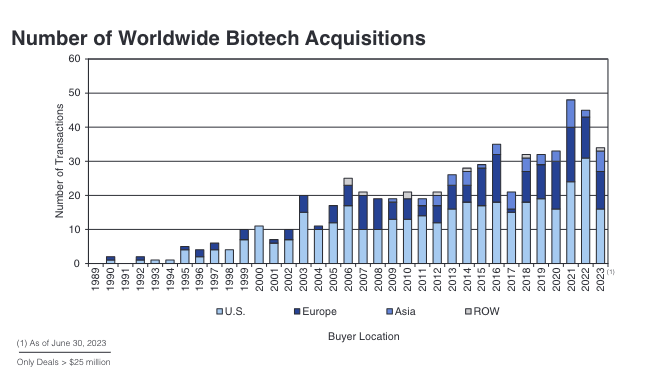Biopharma Stock Check: Market Review and Outlook
Exploring the pharma and biotech financing, M&A, and stock market pictures through the first half of 2023—and implications for the future, as market challenges continue to weigh heavily in senior management decision-making.
Peter Young
CEO and president
Young & Partners

Although the pace of innovation was strong for both pharmaceutical and the biotech companies and the pace of the US and European drug approvals continues to be solid, the financing, M&A, and stock market situations were divergent in 2022 and the first half of 2023.
THE STOCK MARKET AND FUNDING
Pharmaceutical share prices and valuations were strong in 2022, but they did poorly in the first half of 2023, increasing by only 1.1%, according to company data.* The positive news from the industry’s response to the COVID-19 pandemic and increased R&D productivity has been replaced by concerns about price regulation pressures and the fading tailwinds from the pandemic.
As we all know, there has been a huge decline in the biotech stock market prices and the number of IPOs and secondary offerings. For example, the number of IPOs dropped from 126 in 2021 to 17 in 2022 and only six in the first half of 2023. This has made it much harder to raise money for public and private biotech companies. The only positive was some improvement in the share values of the Young & Partners mid- and small-capitalization biotech index in the first half of this year.
Many biotechs who had plans to go public have been having serious funding problems since the IPO market has been an important source of very attractive equity funds to extend their research and regulatory runways. This has driven many to sell themselves earlier than they would have previously.
The drop in biotech stock market valuations has also pushed down the private equity funding valuations and availability. Venture capital firms took big paper losses on their existing ownership positions in private and public biotech/biopharma companies and dramatically slowed funding, except in the hot areas of technology. Their focus has been on defending their existing portfolio companies to make sure they survive the funding and IPO drought. However, there are signs that investing activity is picking up as venture firms take advantage of lower valuations and because they really cannot stop investing entirely.
With many of the private biotechs running out of money, we will continue to see downsizing announcements on a regular basis. Some biotech companies will not survive and will have to shut down. This down cycle has happened to biotech many times historically; so, this is not a new development in the history of the industry.
PHARMA M&A: FIRST HALF OF 2023 VS. 2022
Acquisitions of biopharma companies by pharma have traditionally been a regular part of their business strategies. Although Big Pharma companies have revived their ability to invent new drugs, they still need to supplement their own efforts with acquisitions of and collaborations with mid-sized pharma and biotech organizations. This is particularly true for companies facing patent cliffs for their major drugs. However, the need and desire to acquire other pharma companies is now diminished.
Only 12 deals worth $5.3 billion were completed in the first half of 2023 vs. 42 deals totalling $59.9 billion for all of 2022. This represents a dramatic decrease on an annualized basis of the dollar volume and the number of deals, respectively.
However, the dollar volume may end up stabilized at last year’s levels, as the pipeline of deals on a dollar basis is strong, with two large deals announced: Pfizer’s acquisition of Seagen for $44.5 billion and Amgen’s purchase of Horizon Therapeutics for $30.2 billion (early last month, the FTC settled its challenge to the arrangement). As of June 30, the dollar value of deals announced but not closed was $81.7 billion (nine deals), including the planned Amgen-Horizon merger.
Big Pharma’s balance sheets and cash flows are strong in general; so, these companies have a great deal of dry powder. However, their more selective, cautious acquisitions of medium-to-small pharma companies is a reflection of concerns about the overall business environment, a move away from mega deals, and access to a wide variety of other strategic asset avenues, such as biotech acquisitions, partnering, and licensing.
Big Pharma companies have rightly come to realize that mega mergers/acquisitions are less effective compared to targeted acquisitions of pharma companies for a specific strategic purpose. The mega deals in the past did have significant cost synergies; but for the most part, they did not drive an increase in innovation and research results.
The M&A market outlook for pharma deals will likely be a decline in terms of the number of deals, but flat to potentially much higher in terms of dollar volume.
Figure 1: The amount of deals completed in the first half of this year was at a record-breaking annualized pace.
Source: Young & Partners

BIOTECH M&A: FIRST HALF OF 2023 VS. 2022
In the first half of 2023, 34 deals worth $30.9 billion were completed vs. 45 deals worth $24.3 billion in 2022. In other words, the total dollar volume and number of deals rose dramatically on an annualized basis compared to 2022. There was one large transaction, the $9.6 billion acquisition of Prometheus Biosciences by Merck & Co. But even if you take that deal out of the totals, the pace is much higher than last year. As you would expect, the largest volume of M&A deals for biotech was in the US with 24 of the 34 deals in the first half of 2023. Eight of the remaining 10 deals were done in Europe.
There is a distinct possibility that we will have a record number of deals and dollar volume this year compared to the yearly numbers going back to 1986. The pipeline of deals is also very strong. The dollar value of the pipeline of deals announced but not closed as of Sept. 30 was healthy at $11.2 billion (14 deals).
What is driving this trend? First of all, most of the acquisitions are being initiated by pharma companies who are aggressively looking to build their pipelines and revenues. Second, with the collapse of the IPO market, a severe reduction in equity funding, and a dramatic reduction in the share prices of biotech companies, biotechs are more willing to consider a sale of the company at an earlier stage than they were just a year and a half ago.
What is the outlook for biotech M&A? We expect more of the same in the future, driven by the same factors, with a relatively robust number and dollar volume of deals being completed the next couple of years, along with strategic partnerships and licensing.
SENIOR MANAGEMENT’S APPROACH
Management will be heavily focused on acquisitions where there are compelling strategic rationales and where the same results cannot be obtained internally or through licensing and strategic partnerships. However, it will be challenging to determine what the right valuations are for each deal. With the collapse of the public market values for biotech companies and the downward repricing of private biotech companies in down rounds, matching buyer and seller expectations will continue to be a challenge.
Although we are facing likely recessions in many global regions, the EU in particular, no one expects the downturn to last for a long time; and pharmaceuticals are much less cyclical than most industries. The war in Ukraine and the geopolitical tensions between the West and China have become severe, but these factors will not have a dramatic effect on drug demand or strategies.
However, the ongoing challenges related to the supply chain, the dependence on China and India for active pharmaceutical ingredients and drug production, and the efforts globally to constrain drug pricing will have an effect over time on pharma companies and the role that M&A will play in their strategic plans.
* All data cited in this article were created by Young & Partners’ internal research group.

Addressing Disparities in Psoriasis Trials: Takeda's Strategies for Inclusivity in Clinical Research
April 14th 2025LaShell Robinson, Head of Global Feasibility and Trial Equity at Takeda, speaks about the company's strategies to engage patients in underrepresented populations in its phase III psoriasis trials.
Beyond the Prescription: Pharma's Role in Digital Health Conversations
April 1st 2025Join us for an insightful conversation with Jennifer Harakal, Head of Regulatory Affairs at Canopy Life Sciences, as we unpack the evolving intersection of social media and healthcare decisions. Discover how pharmaceutical companies can navigate regulatory challenges while meaningfully engaging with consumers in digital spaces. Jennifer shares expert strategies for responsible marketing, working with influencers, and creating educational content that bridges the gap between patients and healthcare providers. A must-listen for pharma marketers looking to build trust and compliance in today's social media landscape.
Pfizer, GSK Gain ACIP Recommendations for RSV and Meningococcal Vaccines
April 18th 2025The Centers for Disease Control and Prevention’s Advisory Committee on Immunization Practices voted to expand access to Pfizer’s respiratory syncytial virus vaccine Abrysvo for high-risk adults in their 50s and voted in favor of GSK’s meningococcal vaccine, Penmenvy, for streamlined adolescent protection.